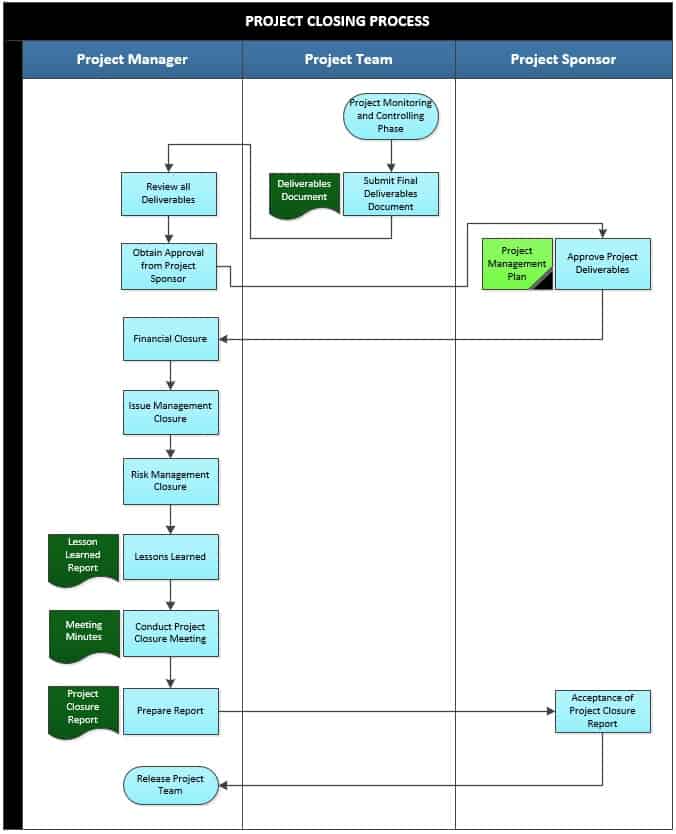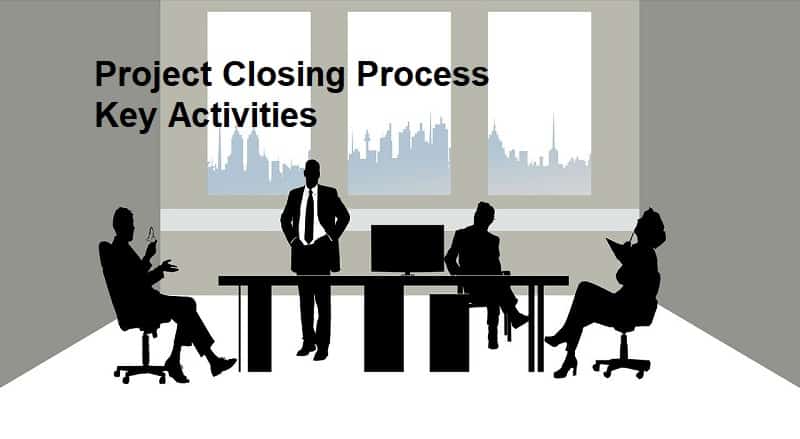The project closing process concerns activities conducted to officially conclude and terminate all activities, tasks, and parts of a project. Notably, this process concludes by approving, accepting, and transferring final deliverables to the customer or assigning party. This process is based on the PMBOK framework and this affirms that it is a proven practice that is applied widely in project management.
It is vital to fully complete this process at project conclusion for several reasons. It provides an assurance that a project is closed and further charges cannot be attributed or accrued to that particular project. Moreover, it confirms that the project has been concluded and this permits reassignment of faculty and staff assigned to that project to a different activity or task. A post-implementation review of the project is carried out to identify lessons learned. Also, the review determines if the project was executed in accordance with the plan.
The objectives of the project closing process are to:
- Ensure project deliverables are approved and transferred to the assigning party.
- Assess whether the project was done in accordance with the plan
- Make sure that all project plans and documentation are transferred to the client and archived
- Release project team members involved in the project
- Determine the lessons learned throughout the project
The scope of the project closing process includes:
- Approval and acceptance of project deliverables and reviewing if they meet the requirements
- Transferring project documentation and plans to the assigning partly for archiving
- Issue management, financial, and risk management closure
- Gathering the lessons learned from the project
- Conducting project closure meeting and releasing the project team

The project closing process consists of the following activities.
1. Submit Final Deliverable Documents
The final deliverable documents contain the service or product produced by a project for the client, customer, or the project sponsor. In other words, the documents detail items that have been developed for the assigning party. The delivery of the final deliverable documents is among the objectives of a project. The submission of the final deliverable documents is a vital activity that facilitates communication of what has been achieved.
Using these documents, the client can determine whether the deliverables meet the set quality standards. The client or customer utilizes the deliverable documents to make a review of what has been achieved. This helps to make an informed decision regarding the approval of project deliverables. Thus, the deliverable documents are prepared by the project team who subsequently deliver them to the project manager.
After receiving these documents, the project manager conducts a review to make sure that all deliverables have been recorded. A project usually has internal and external deliverables. While internal deliverables make a project run, they do not constitute the product expected to be seen by the end users. But external deliverables are the product that is delivered to the client or end users. Thus, the project manager reviews the deliverable documents to make sure that all the required information is captured.
Besides, the project manager ensures the completeness and correctness.
Following the review, the project manager seeks the approval of the project deliverables from the client. The client takes time to assess the deliverables and determine whether they are in line with the requirements and expected outcomes. Verification is important for the client to ascertain that the project delivers the expected results. A client or customer expects to receive a product or service that satisfies his expectations. Thus, the project manager should ensure that right from the project initiation stage, customer expectations are considered so that their fulfillment is guaranteed at the end of the project. Thus, after ascertaining that the requirements have been fulfilled, the client makes a formal approval of deliverables by accepting and signing the deliverable documents.
After the approval of the client, the project sponsor goes ahead to approve the project deliverables. This happens after the client has confirmed that project deliverables are satisfactory. Besides, the project sponsor makes sure to reference the Project Management Plan to further confirm that the deliverables are in line with the outcomes projected at the planning stage. Therefore, the project sponsor conducts a review of the final deliverables to make sure they meet the requirements specified in the project management plan.
2. Financial Closure
This activity aims to review all the pending project payment and clear them. Different suppliers deliver particular goods or services to facilitate the implementation of the project. Thus, during the project closing process, unpaid supplied are compiled and finances for the same are released to respective suppliers. All other pending payments are also determined and processed. The project manager takes the responsibility of ensuring that all payments are cleared. For instance, the project manager achieves this by preparing a list of all pending payment and approving their clearance.
3. Issue Management Closure
Stakeholders may have some issues concerning the project and the final product. This activity aims to identify and resolve such issues. All stakeholders’ issues regarding the project outcomes should be identified through this activity. Once identified, the project manager works closely with affected stakeholders to discuss their specific issues and resolve them. The project manager clarifies the effect of the final product or service to the stakeholders or processes and operations of the company. Thus, the project manager resolves issues by identifying them and coming up with appropriate responses for every issue.
4. Risk Management Closure
Here, the objective is to gather all the risk issues that were encountered in the course of planning and implementing the project. In this activity, documentation of the risk issues identified is done. In addition, relevant mitigation strategies and responses are also documented. Therefore, the project manager reviews all threats faced in the project and records appropriate ways to address them.
Related Articles:
- Project Initiation Process: 6 Key Activities
- Project Planning Process: 7 Key Activities
- Project Execution Process: 8 Key Activities
- Project Monitoring and Control Process: 10 Key Activities
- Project Handover Process: 11 Key Activities
- Risk Management Process: 11 Key Activities
- Quality Management Process: 9 Key Activities
- Change Control Process: 8 Key Activities
- Issue Management Process: 9 Key Activities
5. Lessons Learned
Implementing a project is a learning experience. Thus, this activity seeks to identify what stakeholders learned in the course of implementing the project. Stakeholders in a project have different levels of involvement. Thus, it is vital to involve all stakeholders in this activity to identify their specific lessons. The lessons learned in a project need to be preserved for future reference. Therefore, the project manager works with all stakeholders to collect the lessons they learned. At the end of this activity, the project manager develops a Lessons Learned Report.
6. Conduct Project Closure Meeting
Convening a project closure meeting is the best way to end any project. The meeting aims to have the project owner agree with the idea of closing the project. The project manager can increase the chance of getting the project owner to approve the closure by having a set agenda for the meeting.
During the meeting, a description of the project purpose should be done. Some projects take a long time to complete and it is likely that some individuals may not recall the original purpose. This makes it vital to remind the stakeholders about the original purpose. Then, a review of what the project has achieved should be done. The project manager should guide the stakeholders in reviewing whether the project has delivered all that was expected.
Any extra work performed should also be identified. If there is any area that the project failed to deliver, it should be noted. This will bring about the question of why there were variations between the end product and expected results. The project manager should be honest with the stakeholders and explain the reasons that cause the variation.
The project manager should ensure that the project owner understands every detail of concern, and also elaborate about the project handover work including support that will be provided after project closure. These details are important particularly to the project owner to ensure that after agreeing to the project closure, complaints will not arise. After setting the project background, the project owner should be given the chance to close the project. the output document in this activity is the Meeting Minutes.
7. Prepare report
This activity is concerned with the documentation of all the activities involved in the project closing process. The success in the project is recorded to aid future project managers and stakeholders obtain guidance and achieve better results. This activity ends with the preparation of the Project Closure Report, which is the output document of this activity. This report is presented to the project sponsor who formally receives and approves it.
8. Release Project Team
The objective of this activity is to release the employees who were involved in the project. This happens after successful project completion. The activity aims to have the employees get back to their usual duties or assigned another project.
Conclusion
The project closing process is critical in the project lifecycle because if a project is not closed, additional cost will continue to be incurred. To avoid this, stakeholders should understand and follow these project closing activities to guarantee more effective and better outcomes.

